Sun, sea, and palm trees. A dream for many and rightly so. I might also add that the number of speed cameras can be counted on one hand and no large capacity bikes ever get stolen! Oh, I almost forgot to mention that there are no traffic police. “Fantastic!” I hear you say, all the things that a rider would want.
Well, nothing in this life is ever perfect. Here’s a list of things we frequently contend with:
- Typhoons
- Earthquakes
- Volcanic eruptions
- Monsoon rains and flooding
- Poorly maintained roads
- Drivers who have never passed a driving test
- Humidity regularly in the 90-100% range
- Limited medical facilities
- No breakdown services
- Very limited dealer servicing
- All spare parts have to be purchased online
- Eye-wateringly expensive second hand “big bikes” (400cc and above)
Not so much of a riders dream now, is it? However, despite the difficulties, big bike ownership is increasing. You just can’t keep a rider down!
The Philippines, like most Asian countries, have always had large numbers of small capacity bikes, be it 150cc regular bikes or Underbones. There are also increasing numbers of what I call scooters (think Yamaha NMax). Originally, they were Japanese but in recent years there has been a dramatic increase in Chinese brands. The number of riders has always been high and by high, I mean 30 million riders out of a population of 100 million! They have flourished because they afforded the general populace with a cheap (relatively) and a reliable form of transportation. The vast majority of these machines are small cc bikes.
Big bikes were originally imported into the Philippines by individuals or organizations. Most of these were brought in illegally and without paperwork, however, in recent years there has been an increase of interest in big bikes with all of the main Japanese, Harley, and European brands opening dealerships.
This was good but it did not provide the expansion into the market that was being hoped for because the prices of these bikes were well beyond the average Filipino wealth level. The dealers recognized this and they have now formed alliances with the local banks to promote loans for the purchase of these large capacity machines. Even with these improvements, big bike ownership remains almost exclusively the province of the middle class and up.
What this has created is a 3-level motorcyclist culture. There are the small bike class, the 400cc class, and then there are 400cc (Big Bikes) groups.
To understand how enthusiastic the riding scene here in the Philippines is, one has to understand all of these groups.
The Small Bike Class
As mentioned previously, this is the class where the majority of the 30 million are located; don’t dismiss this group. Many ride for purely transport or work purposes but there is a significant number that ride on the weekend for pleasure. There are multiple clubs based on either geographical area or brands and they meet up in groups of up to 100 to ride to scenic or interesting places, or sometimes just for the love of riding. Some of the distances these riders cover is truly amazing and many of them think nothing of covering over 200km in a day.
The bikes in this class range from ubiquitous models such as the Kawasaki Barrako 175, Honda 150 which are used both as solo transport or for connecting up to Tricycles which are used as taxis. At the other end of the spectrum are bikes such as the Suzuki Raider, 150cc of fun with a genuine top speed of over 130kph. That is before they are modified!
A good-looking Suzuki Raider 150. The must-have Underbone. A very desirable machine and often the stepping stone to larger capacity bikes.
The Chinese have made big inroads into this market, offering similar models for just over half the price. The engines are effectively copies of Japanese engines and by and large are reliable. The one area where they still need to improve is in their quality of finish. A bike just 2 years old can often look more like a 6-year-old machine. They are however improving in this area and improving quickly. To the average Filipino, they are great value for money.
A Chinese Rusi. Notice it has two shocks on each side to take the extra weight of a sidecar with passengers.
These are Chinese Rusimachines at a dealership, of which there are many.
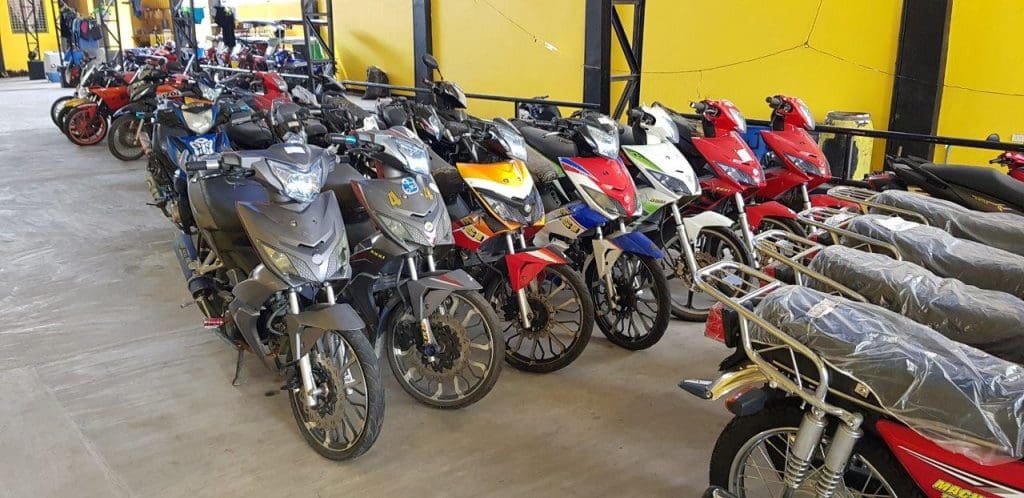 Here is an example of the added value benefits of buying, in this case, Rusi bikes. Aggressive marketing that is winning customers.
Here is an example of the added value benefits of buying, in this case, Rusi bikes. Aggressive marketing that is winning customers.
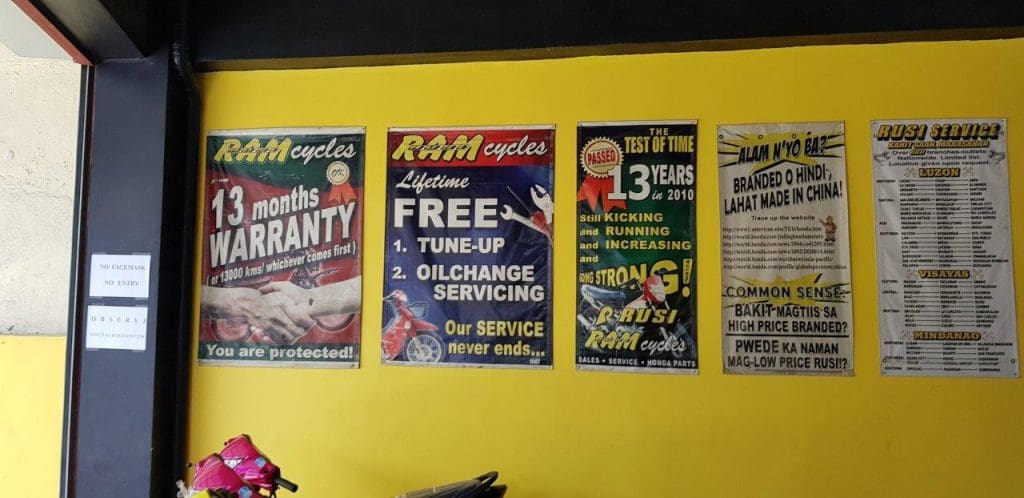 I am also in this group as one of my bikes is a Kawasaki Fury 125 RR. Great fun.
I am also in this group as one of my bikes is a Kawasaki Fury 125 RR. Great fun.
A very important element of the small bike market is modification. I am often stunned at how much young riders will spend to modify their rides. These modifications are primarily either to change the looks of the machine, to make it different to anyone else’s, or to improve performance. Occasionally both. To satisfy this demand, the Philippines has a surprising number of aftermarket suppliers. One such supplier is Silvestre. A relatively new entrant into the market, they supply their own brand products to over 150 different trade clients.
A Silvestre parts shop. No, it does not sell parts for ZX14R’s which is my machine in the parking space.
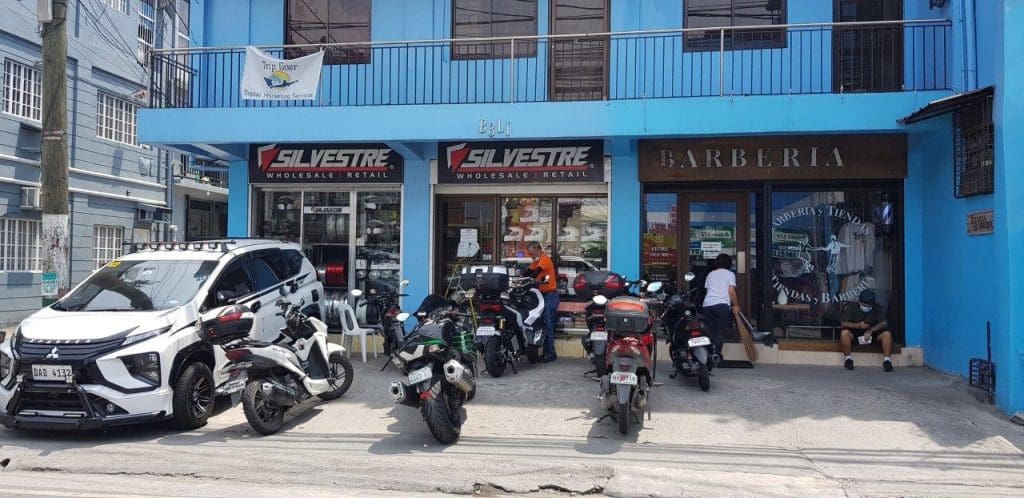 The CEO & President of Silvestre, Andree Silvestre on the left with his Chief Marketing Officer, Jon Go.
The CEO & President of Silvestre, Andree Silvestre on the left with his Chief Marketing Officer, Jon Go.
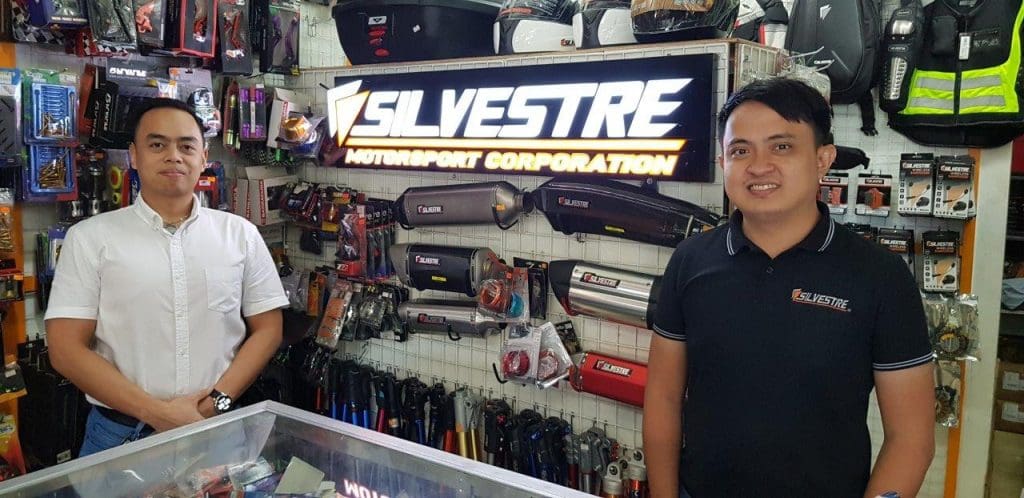 Entering a Silvestre shop is like entering an Aladdin’s cave. They sell everything a young modifier would ever want. In the picture below are the Silvestre branded lubricants and in the background, some of their helmets can be seen.
Entering a Silvestre shop is like entering an Aladdin’s cave. They sell everything a young modifier would ever want. In the picture below are the Silvestre branded lubricants and in the background, some of their helmets can be seen.
Many of their products are sourced from China and a major challenge was for Silvestre to ensure that their Chinese suppliers met the quality standards that will ensure that the buyer is getting exactly what they pay for. This is achieved by having close relations with suppliers and it helps that all of the Silvestre leadership are also riders themselves so they know what a buyer expects.
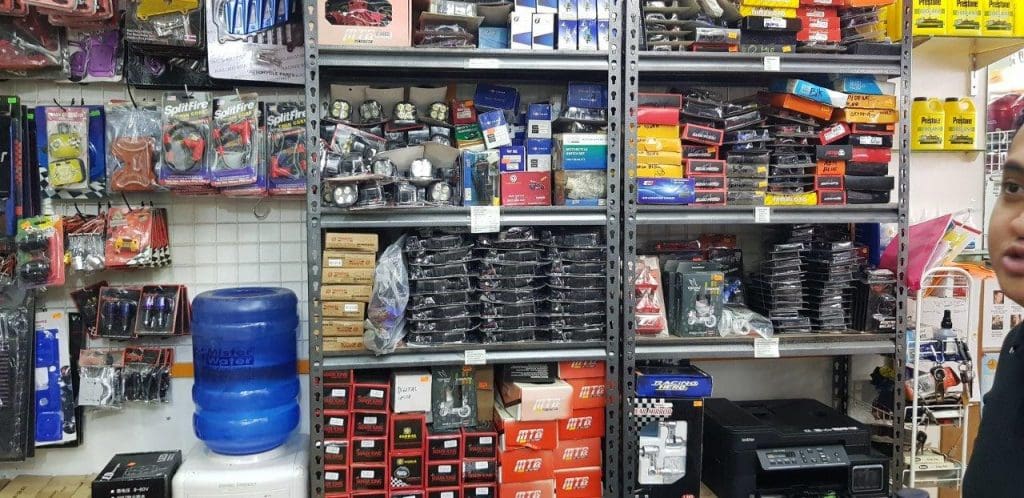 Own brand helmets with built-in LED’s with DOT approval.
Own brand helmets with built-in LED’s with DOT approval.
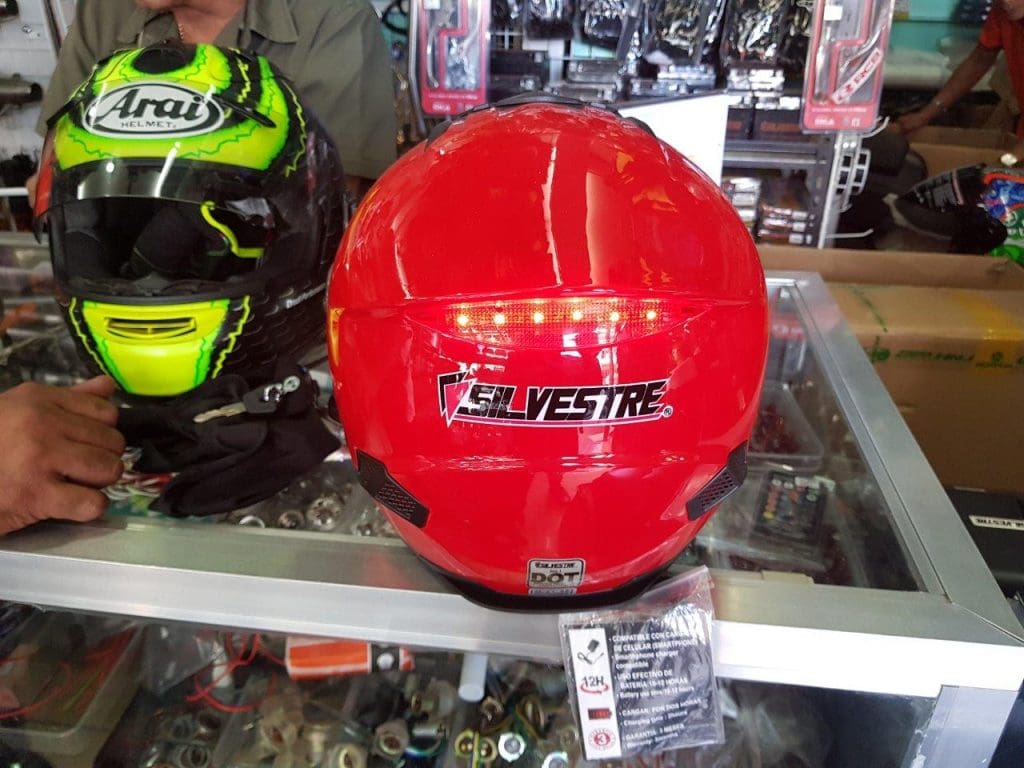 It’s Christmas time. I myself have purchased some riding gear from Silvestre and it has not disappointed.
It’s Christmas time. I myself have purchased some riding gear from Silvestre and it has not disappointed.
The Small Bike Riding Scene
Small bike riders are the heart and soul of the Philippine riding community.
Small and big bike riders visiting the famous Kaybiang Tunnel. It is the longest tunnel in the Philippines and riders gather here after a tremendous ride through twisty, well-tarmacked roads. They often ride through the tunnel at high revs to hear the sound from their highly illegal mufflers. Hey, it’s more fun in the Philippines.
That bike that is chasing you through the bends may be piloted by one of these ladies (you may be thinking it might be a good idea to be caught!) The Philippine Lady Riders Club. These young ladies do not hang about when riding and they have many members.
The Mid-level 400cc Market
The 400cc market in the Philippines is hotly contested. The main reason for this is a law that states only 400cc and above can use the expressways. Kawasaki, being the manufacturer with the largest presence in the Philippines, is the market leader (they have an assembly plant in the Philippines), KTM with the Duke 390, and Royal Enfield are also major players. The new kids on the block are the Chinese and they are rapidly increasing their presence in this market segment with a range of scooters, but the bikes are coming soon. The 400cc class is considered the stepping stone up to the “Big Bike Class” and are able to use the expressway.
Below is the Bristol 400i. This is relatively new to the market but is making waves. Looking closely at the machine, I was impressed and the two riders loved them. A perfect bike for the Distinguished Gentleman’s Ride which has a growing following in the Philippines. ABS, high-quality finish, great sound, radial calipers, and good looks. Looking at the separate rear fender, not sure what were they thinking there. The following quote is taken from their website.
“Bristol motorcycles are developed with quality from renowned international OEM automotive and motorcycle suppliers. Our bikes feature Italian design, electronics from Delphi Technologies USA, Mikuni injection components from Japan, and powertrain from Hartford Taiwan.”
I like this bike. When you look at these machines the word that springs to mind is Quality! Watch out, Japan. Coming to a town near you soon!
Radial calipers on a low-cost motorcycle. Mmm.
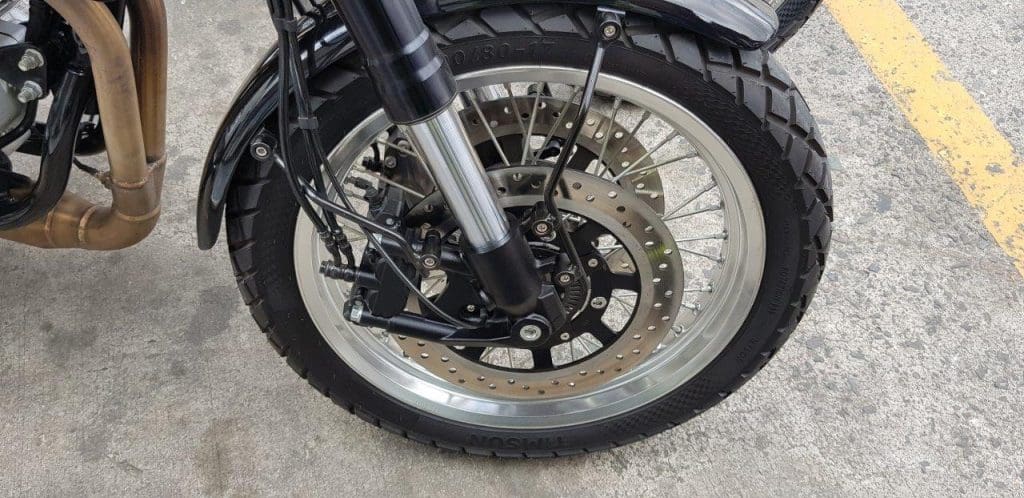 Very neat and tidy with traditional instruments.
Very neat and tidy with traditional instruments.
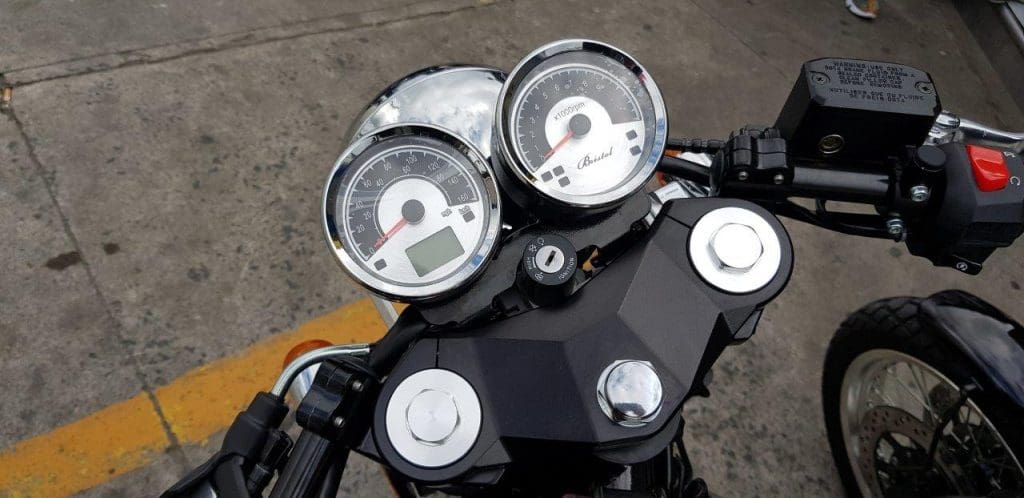 Neat lines and the paint is first class.
Neat lines and the paint is first class.
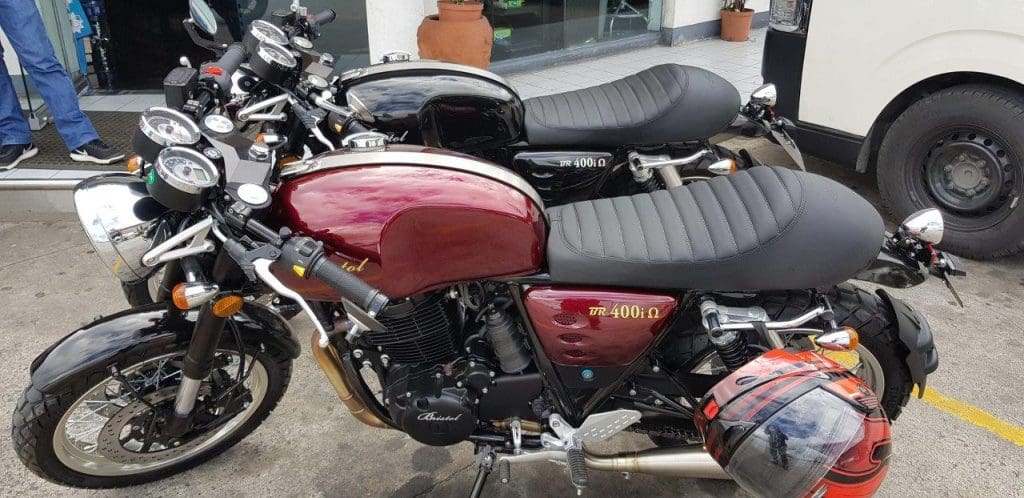 A father and son mounted on a 250cc and 400cc Kawasaki. I think the father wanted to leave an impression for the picture. He did!
A father and son mounted on a 250cc and 400cc Kawasaki. I think the father wanted to leave an impression for the picture. He did!
Big Bikes (Over 400cc)
I am also in this group as I ride a Kawasaki ZZR 1100 and a Kawasaki ZX-14R, historically in the realm of those with high levels of disposable income. Traditionally in Asia, cars were for wealthy people and motorcycles were for those with fewer zeros on their bank statement. This has changed in the last 15 years or so owing to the high price of modern bikes in the larger capacity sector.
Now, if you ride a big bike it is seen as an expression of wealth and leads to the scenario, common in the west also, where some riders parade themselves on their Ducati’s, Harley’s or BMW’s but only do an annual mileage of a couple of thousand km’s. Not real riders, just posers in my opinion.
They normally sell these bikes after a year or two and as is similar to the developed world, these bikes get passed down and eventually reach a price range that is affordable to less wealthy riders. This increases the number of big bike riders which is great but because the parts are still eye-wateringly expensive so the servicing and maintenance is often not done until they break down.
They are then taken to a local bike mechanic who tells the rider the part he needs to put it back on the road. Unfortunately, the owner never ends up ordering the parts (the Philippines has high import duty rates on spares) and abandons the bike. What you end up with is a “graveyard” of bikes left to rot waiting for parts that will never arrive. Look away at the following pictures if you, like myself, hate to see machines rusting away for lack of parts.
Bikes waiting for parts that will never arrive. Many classics end up like this.
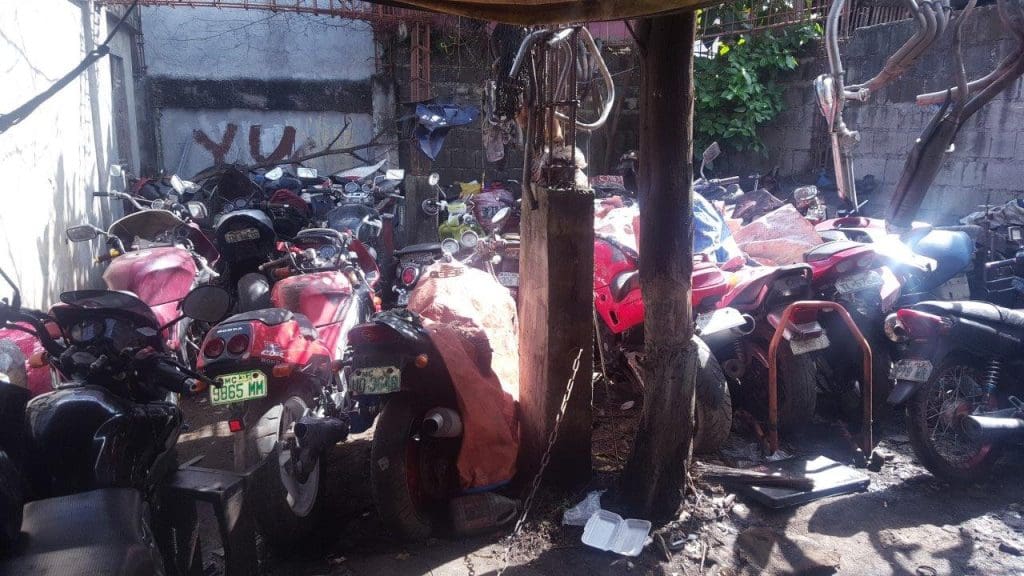 The Kawasaki ZXR 400 on the left of this picture was the fastest of the race rep 400’s of the ’90s and had a real top speed of nearly 140mph and is considered a minor classic. Rusting away.
The Kawasaki ZXR 400 on the left of this picture was the fastest of the race rep 400’s of the ’90s and had a real top speed of nearly 140mph and is considered a minor classic. Rusting away.
Despite this, there are many “Big Bikes” that are ridden and maintained and the range is surprising. From 1950’s BMW’s to the latest sport bikes, you never know what you will come across.
I have included a selection of pictures of the type of bikes I see on a regular basis whilst out riding.
Below is a nice W800. Quite a popular model in the Philippines.
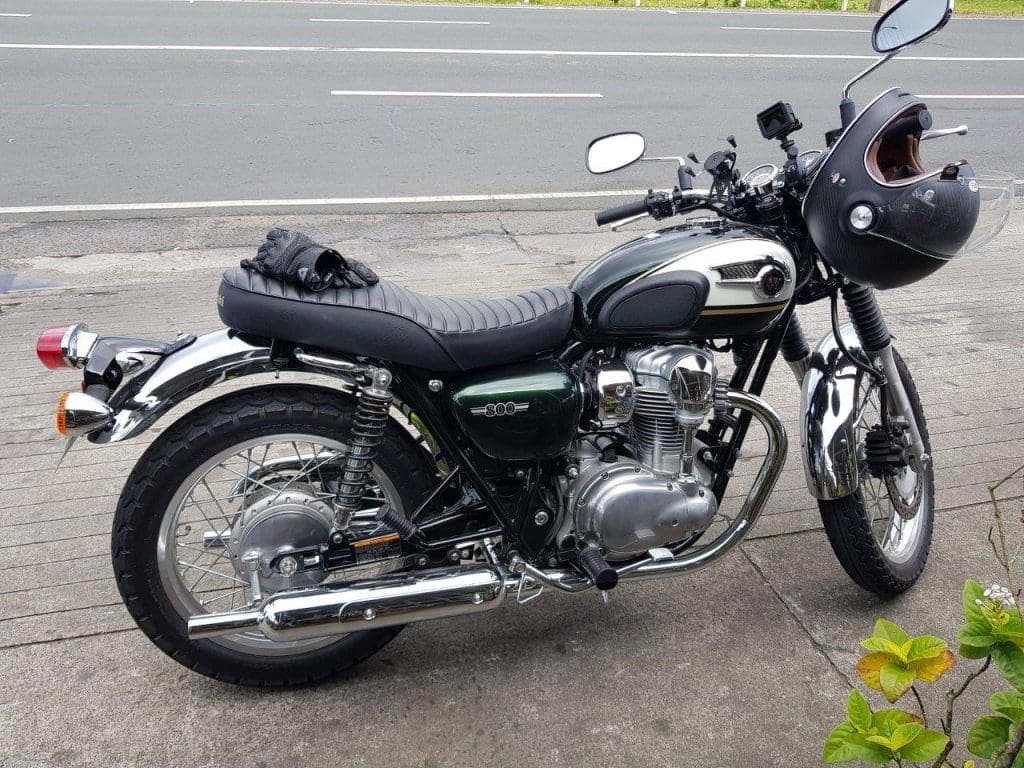 I had to include a picture of my two bikes. You might be getting the idea I am a Kawasaki man and you would be right. ZZR 1100 and a ZX-14R.
I had to include a picture of my two bikes. You might be getting the idea I am a Kawasaki man and you would be right. ZZR 1100 and a ZX-14R.
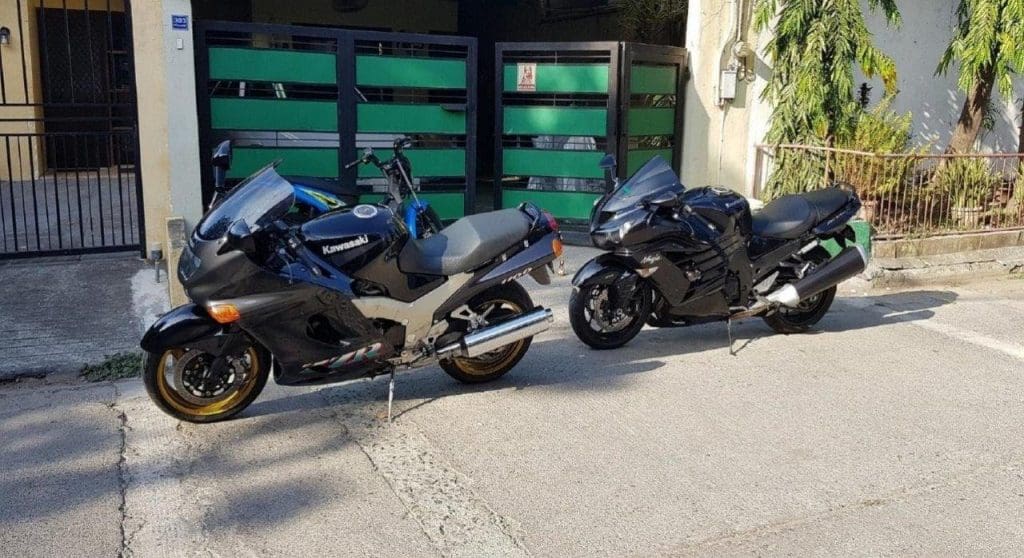 A nice Triumph Triple. They are popular in the Philippines but suffer from a poor reliability reputation. This may be because second or third owners may not maintain them properly. Of course, the spare parts are pricy not least because of high customs duty on parts.
A nice Triumph Triple. They are popular in the Philippines but suffer from a poor reliability reputation. This may be because second or third owners may not maintain them properly. Of course, the spare parts are pricy not least because of high customs duty on parts.
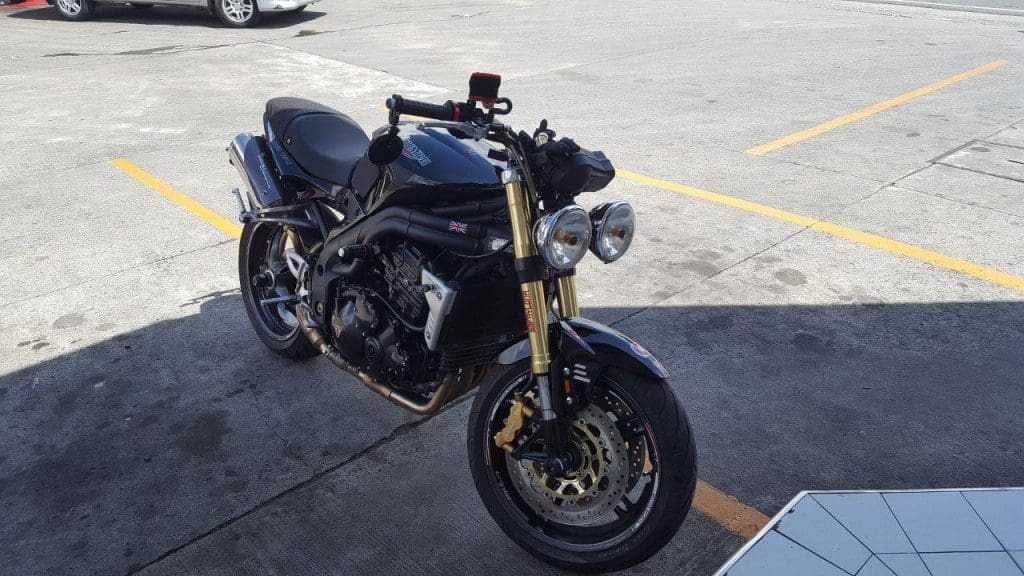 A nicely looked after CBR 600 F4.
A nicely looked after CBR 600 F4.
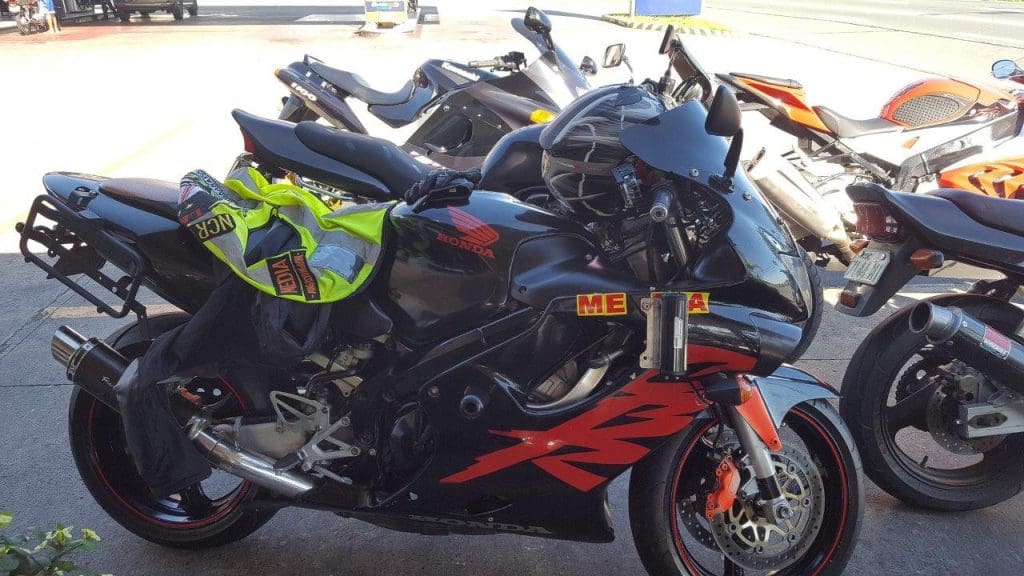 A smart looking CB1300 waiting for routine service. One of the lucky ones!
A smart looking CB1300 waiting for routine service. One of the lucky ones!
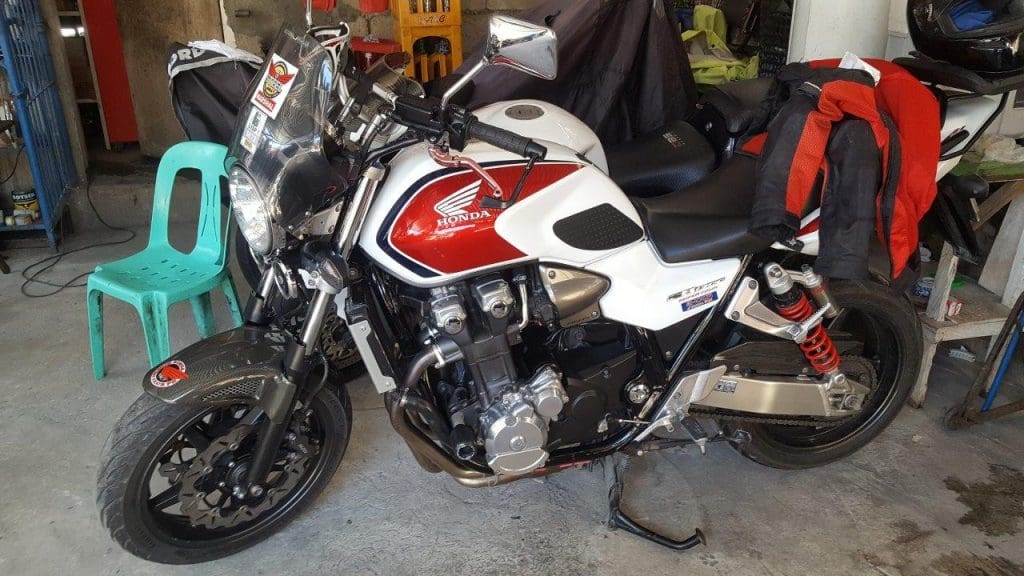 A tidy Aprilia starting for the first time having not run for many years. It started and ran well after some work on the electronics.
A tidy Aprilia starting for the first time having not run for many years. It started and ran well after some work on the electronics.
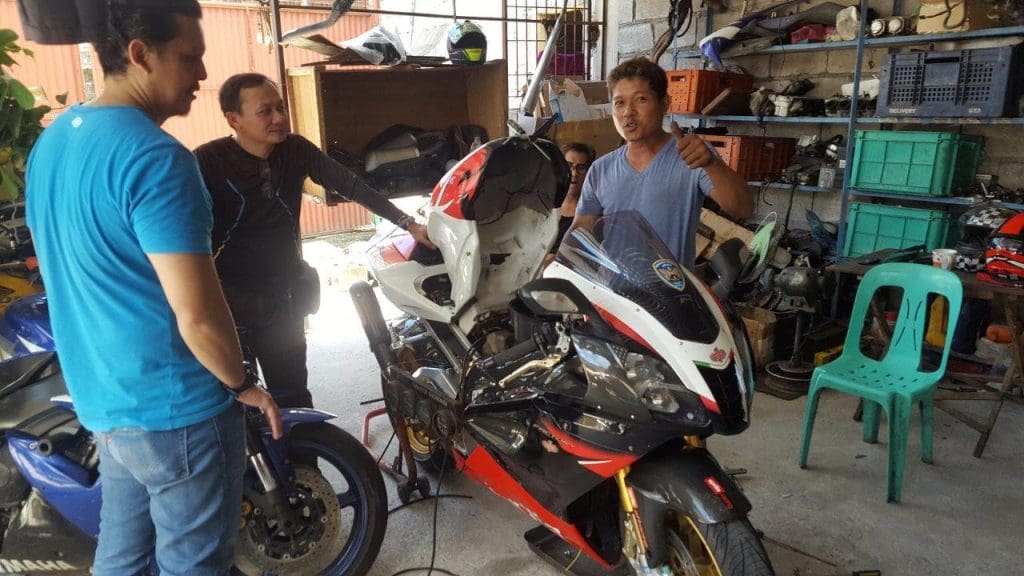 The BMW further ahead of the ZZR than it ever got on the road! Ha! Ha!
The BMW further ahead of the ZZR than it ever got on the road! Ha! Ha!
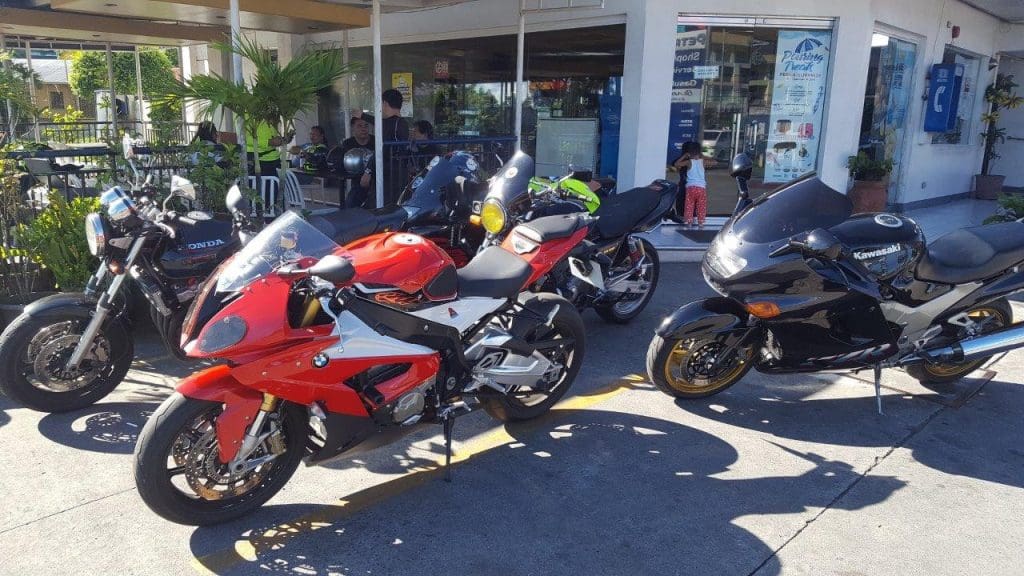 A popular destination on the weekend. A coffee and chat about bikes. The same all over the world.
A popular destination on the weekend. A coffee and chat about bikes. The same all over the world.
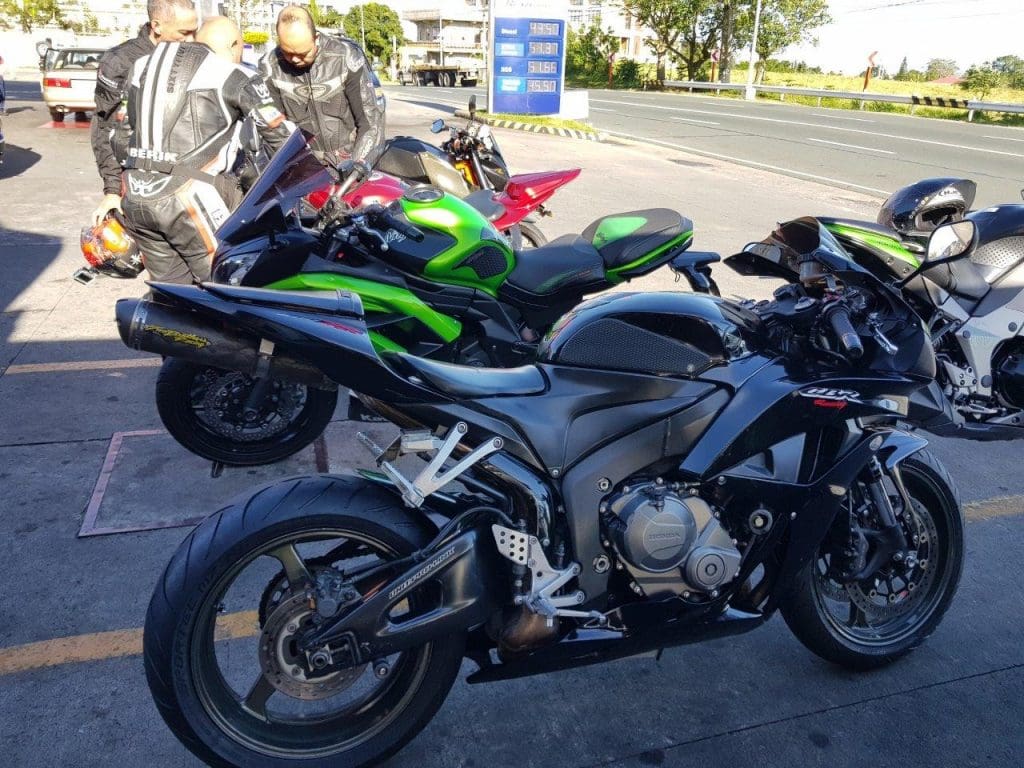 Several Kawasaki’s with the owners doing what owners everywhere do, admiring their bikes!
Several Kawasaki’s with the owners doing what owners everywhere do, admiring their bikes!
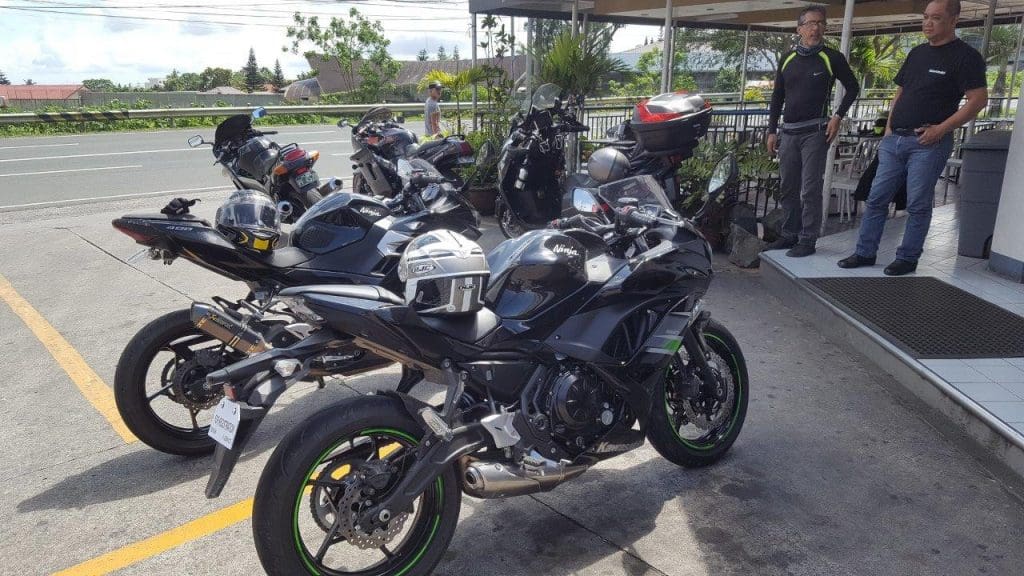 Even a Harley gets in on the act. Actually, there are quite a few Harleys in the Philippines. Some owned by ex-pats but the majority owned by Filipinos wanting to enjoy the laid-back riding style.
Even a Harley gets in on the act. Actually, there are quite a few Harleys in the Philippines. Some owned by ex-pats but the majority owned by Filipinos wanting to enjoy the laid-back riding style.
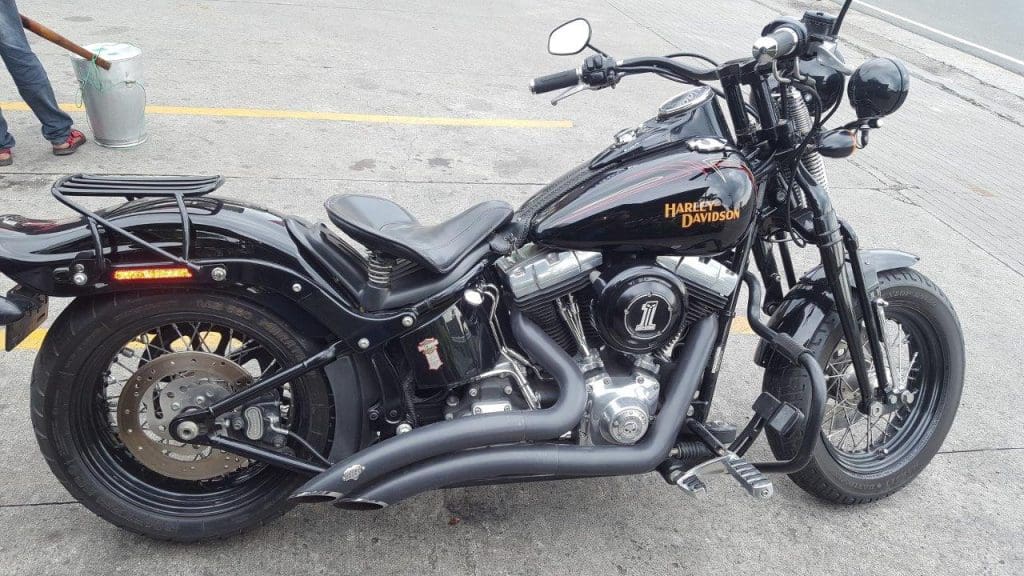 Like father, like son. He gave the 400 to his son and purchased the 250 for himself!
Like father, like son. He gave the 400 to his son and purchased the 250 for himself!
Conclusion
As you can see, the riding scene in the Philippines is healthy and growing despite just about everything being against it. Legislation that does not differentiate between 125 scooters and 1000cc sports bikes, roads that require 100% concentration the entire time due to potholes or errant drivers, the weather that tries to turn you into a human roast each time you ride, and the price of parts and second-hand bikes being far higher than in the West. The love of riding is a universal trait and is demonstrated here by the small bike riders that get on their machines just for the sheer joy of being on two wheels despite the difficulties. Long may it continue.
There are advantages to being in this part of the world though. Kawasaki’s new four-cylinder screamer the ZX -25R is being launched here as I speak. 19000RPM with technical specifications that are normally found on 1000cc exotics. I can’t wait. Living in Asia and being a fan of Kawasaki motorcycles, the temptation to visit the Kawasaki museum in Kobe Japan got the better of me and I had a great trip there.

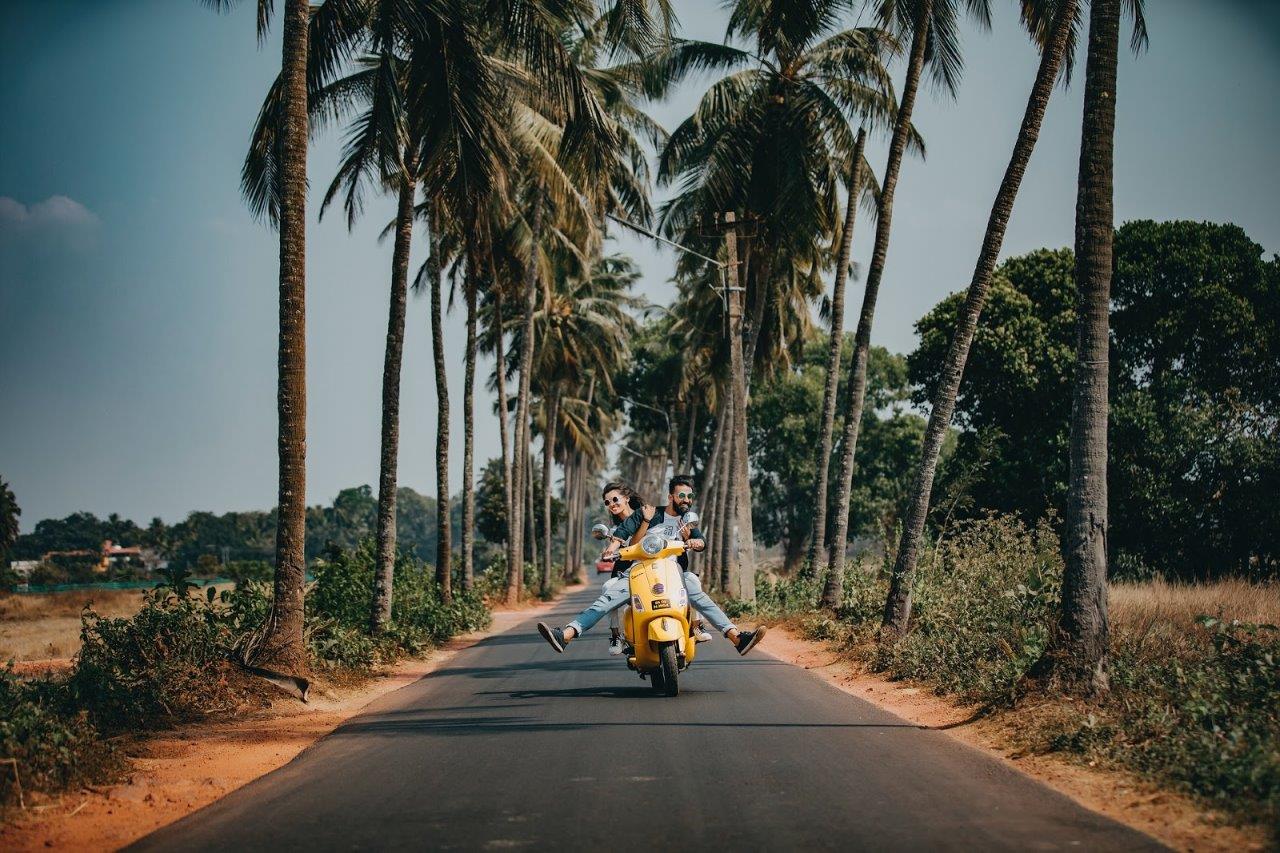
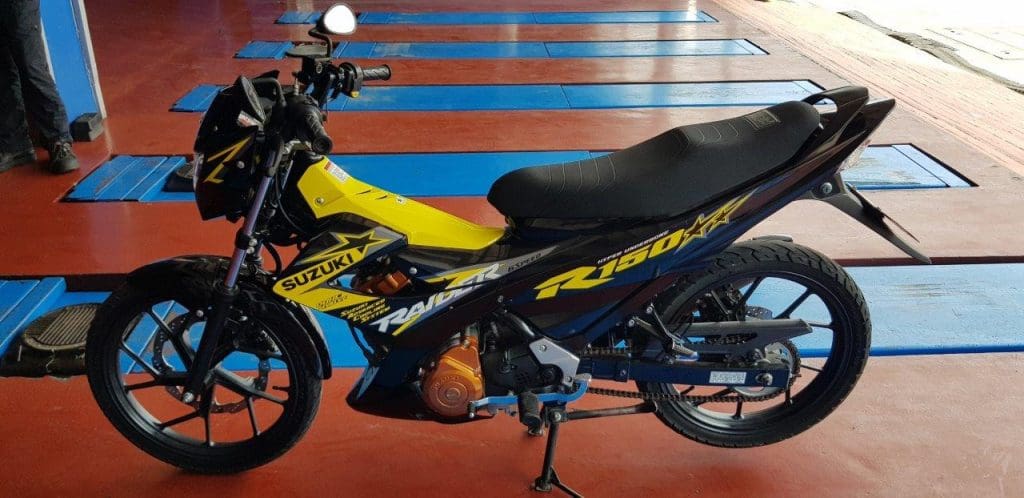
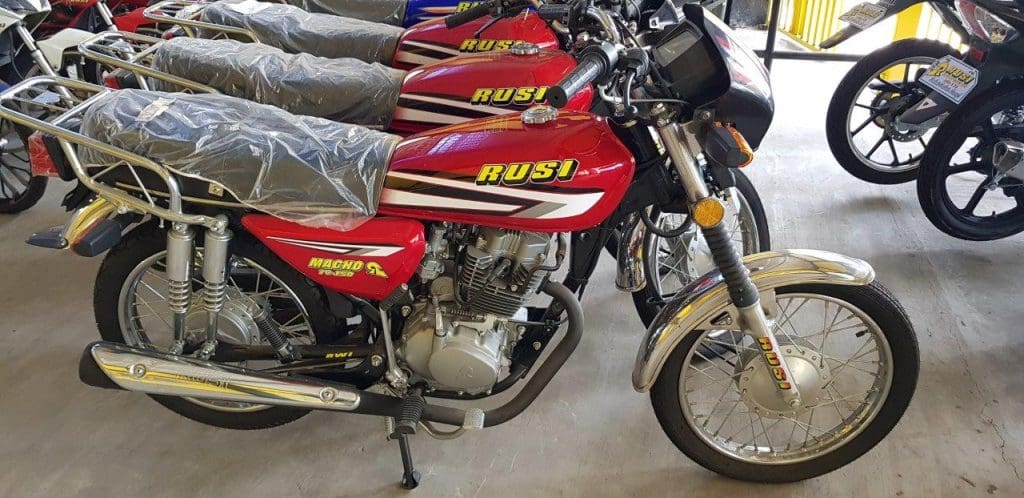
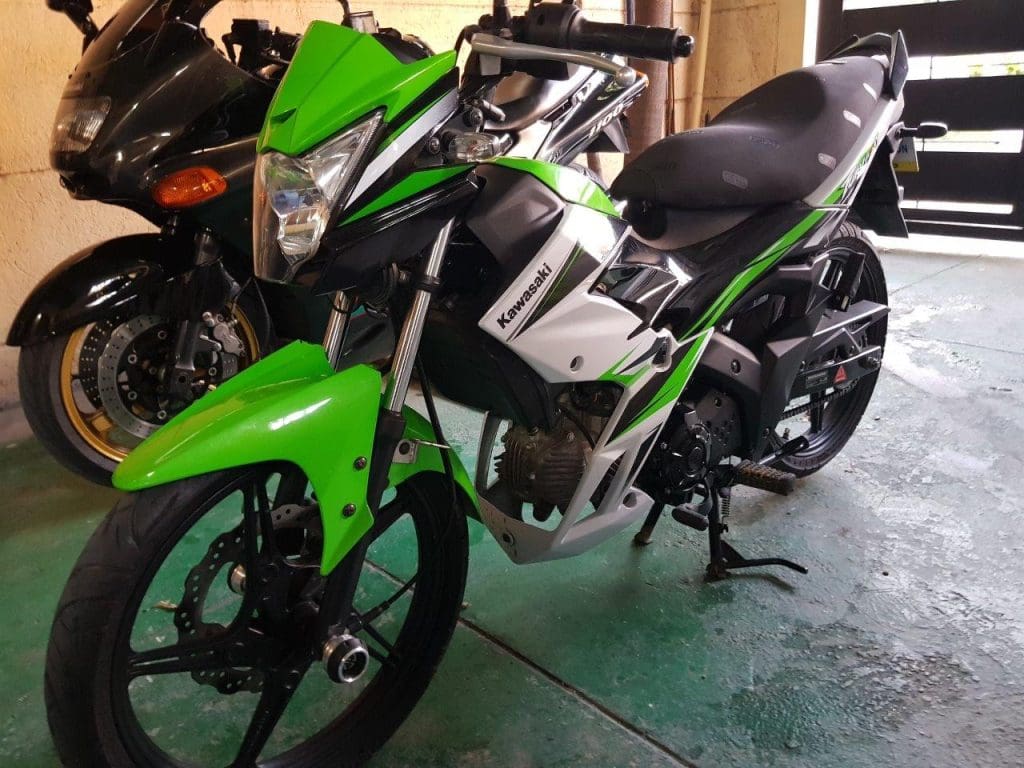
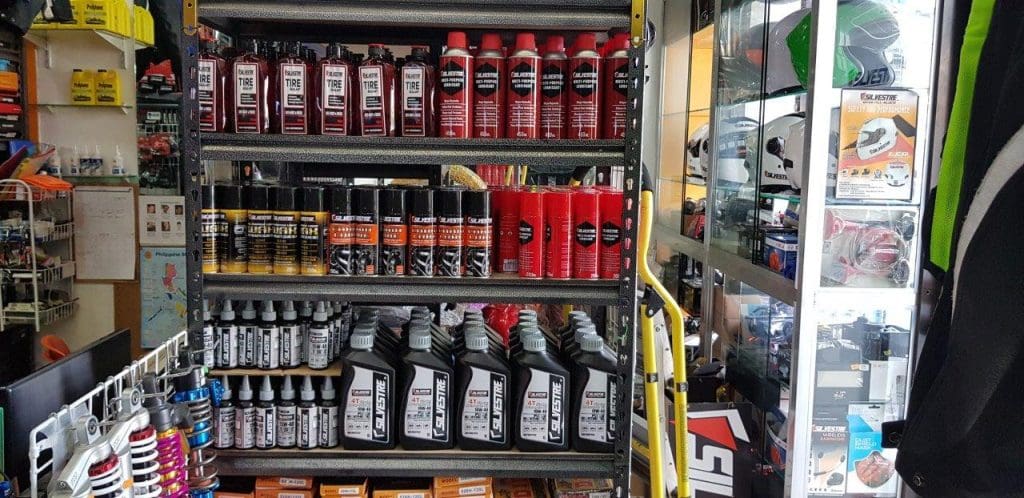
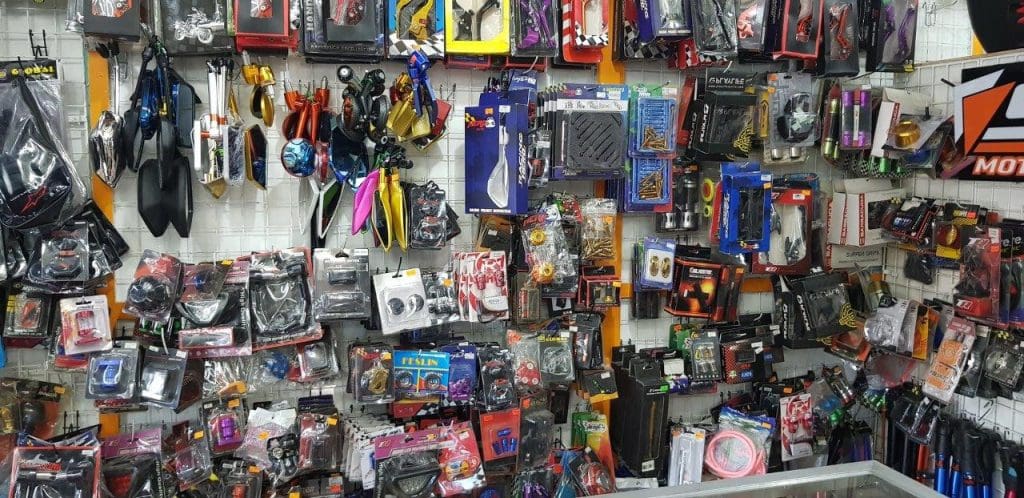
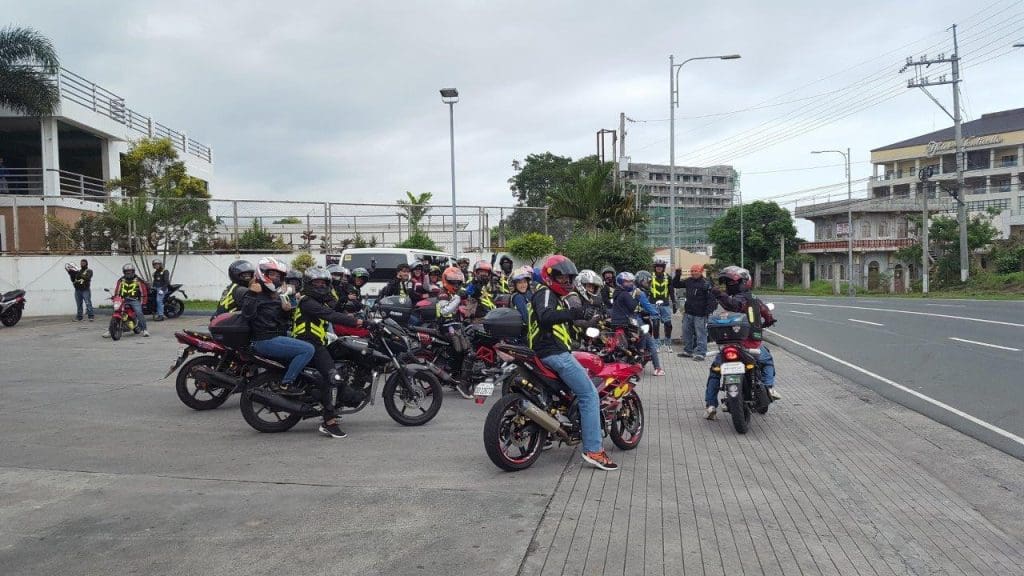
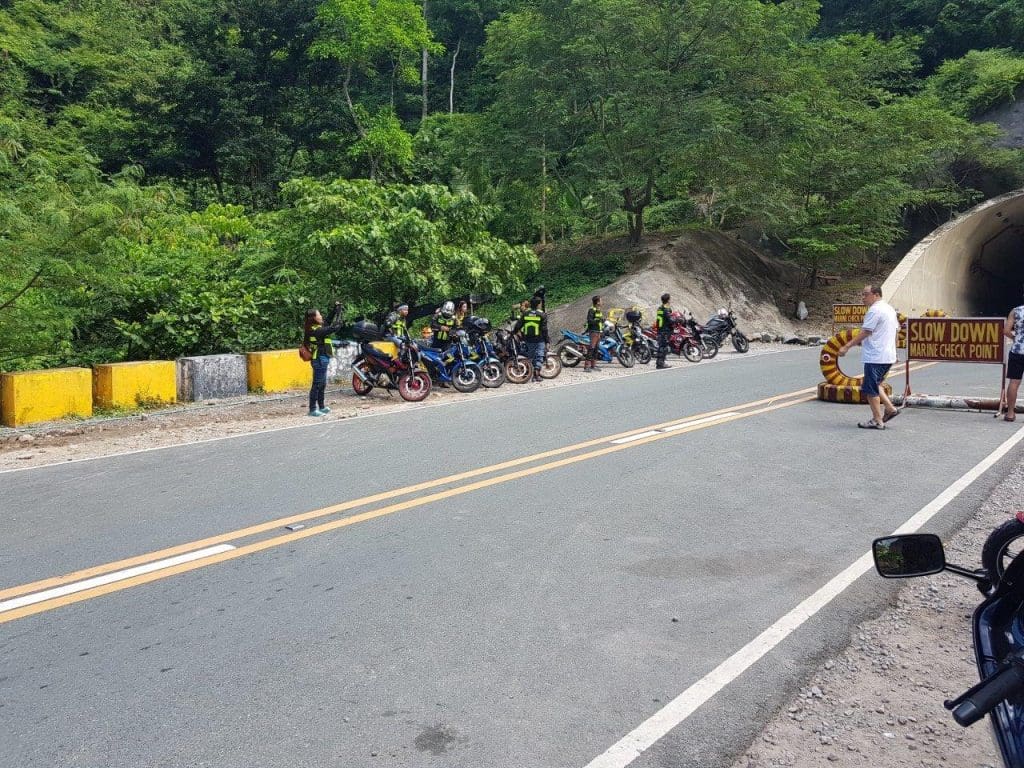
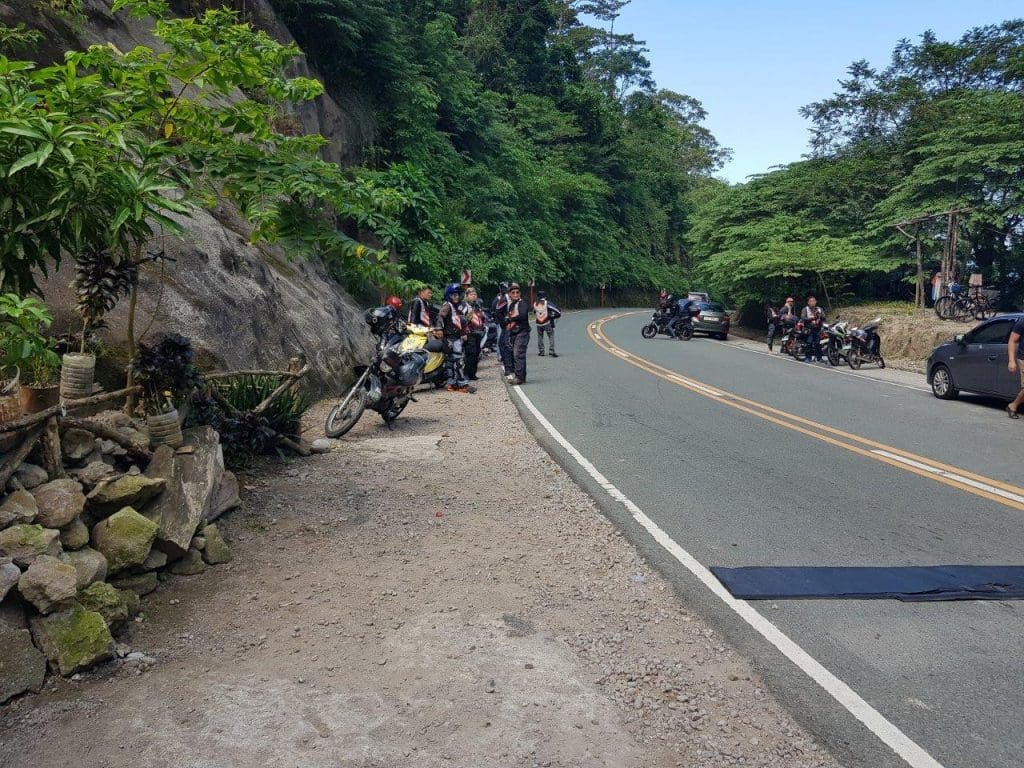
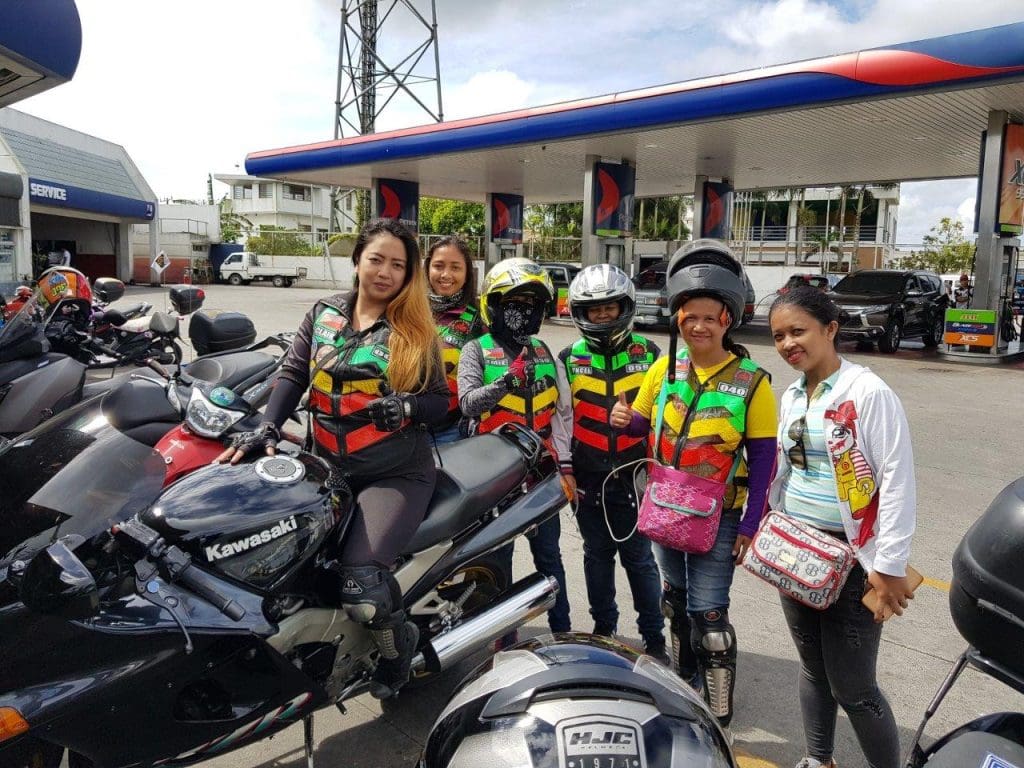
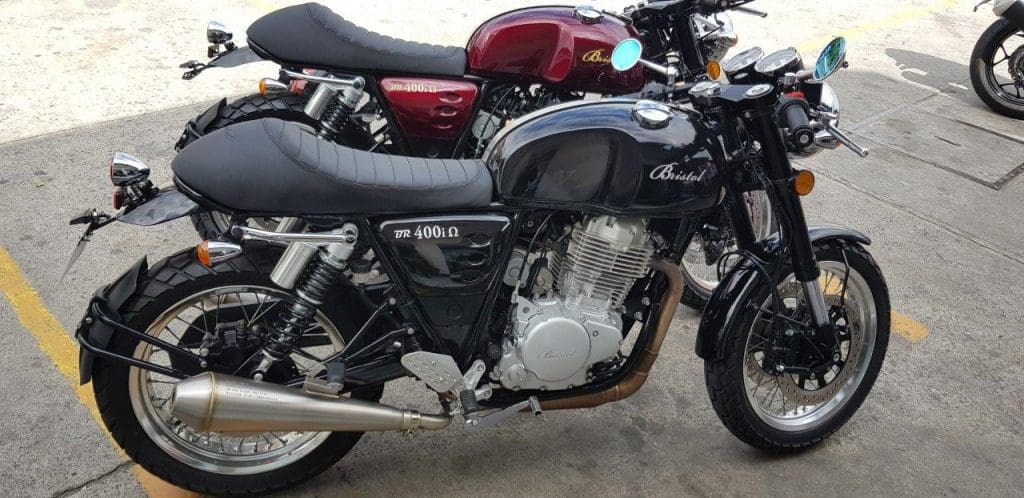
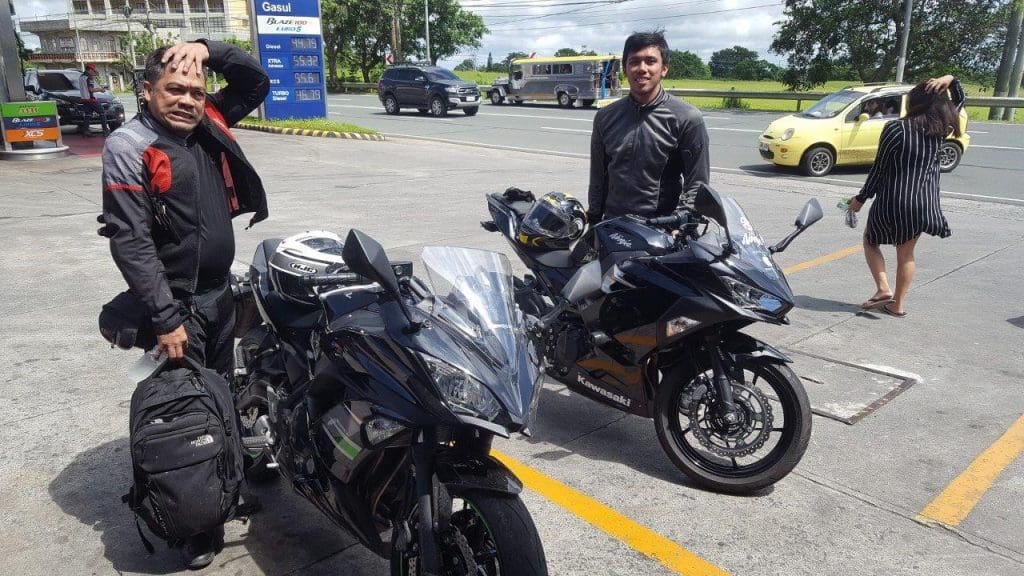
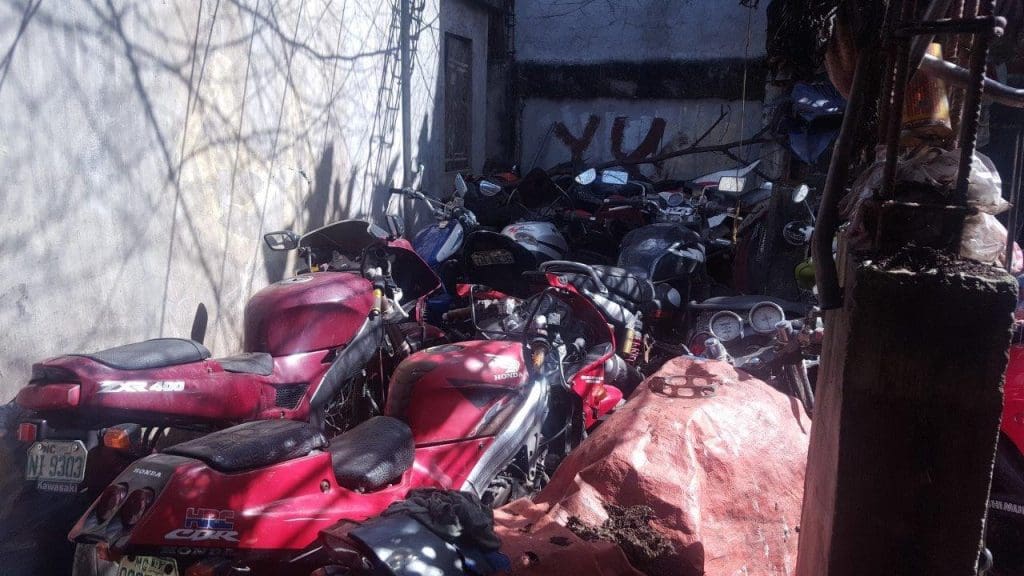
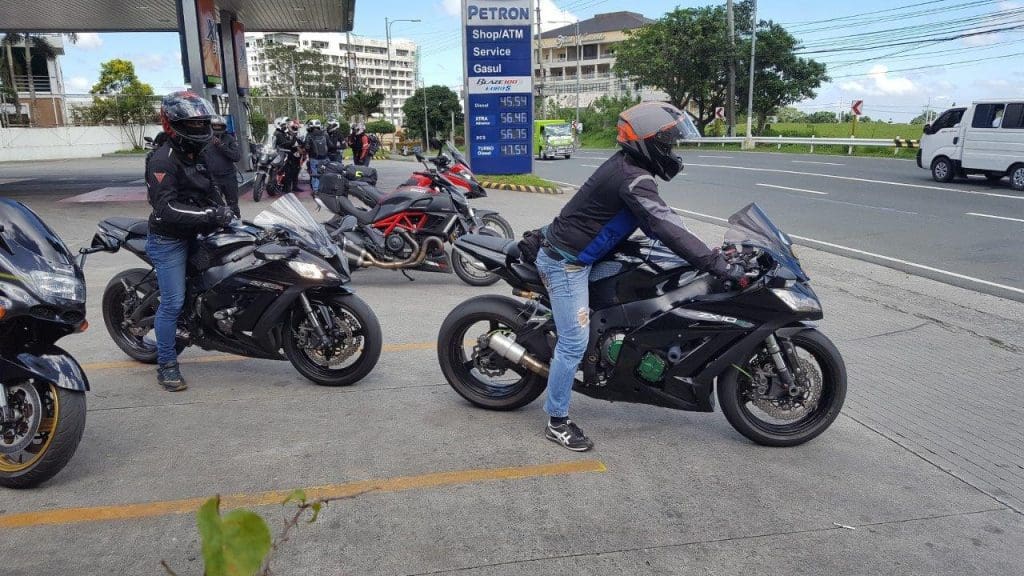

Nice article! First time I have seen someone write about the bike scene in the Philippines.
Thanks for that. I hope to write some more articles on the scene in this part of the world.
Thanks. In developing countries there are many obstacles but love of riding is universal. Where there is a will there is a way.
That Bristol is a nice looking retro-style bike similar in appearance to a Honda GB500 single. Not sure how it would sell in the US where small capacity retro bikes like the Royal Enfield Continental GT languished in dealerships until they developed the larger capacity 650 engine which is an absolute steal
Indeed. People, including me, often forget how much fun can be had riding bikes that do not break the speed limit in first gear. As I mention in the article I have a small Kawasaki and it is such fun. The quality of finish on the Bristol is surprising and the owners have nothing but good comments about it.
I fear you are correct. I, like many have forgotten how much fun can be had on a smaller machine. Sometimes we get blinded by hp numbers.
You forgot to mention the inter-island destinations where adventure bike riders go to by taking a ferry.
There also good trail riding areas for those with trail bikes such as the bullet proof Honda XR, Yamaha Serow and KTM’s.
You are absolutely correct sir. The inter island routes are well established and popular.
You are absolutely correct. The inter island routes are a real adventure. It is something I need to look into more.